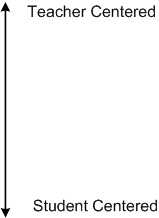Quality of education based upon
how we identify effective teachers
Contents
IntroductionPart I: Education Myths
1. Myths toward Effective Teaching
2. Myths toward the Lecture Method
Part II: Effective Ways of Teaching
1. Structure of Instructional Continuum
2. Knowing Students' Background
3. Setting up Objectives
4. Psychological Security for Students' Leaning Environment
5. Advantages of Teacher Questions
6. Outcomes of the Grouping Process
7. Elements of Effective Instruction
Part III: Making Curricula and Performing Assessments
1. John Goodlad's Five Levels of Curriculum
2. Elliot Eisner's Three Levels of Curriculum
3. Assessment of Three Main Domains
Part IV: Conclusions and Discussions
Reference
What do students really want for the university education?
Part II: Effective Ways of Teaching
Teaching is not only limited to a simple category such as lecture and laboratory. There are several strata of the methods. The book indicates the following:
1. Structure of Instructional Continuum
| Lecture |  |
| Demonstration | |
| Questioning | |
| Discussion | |
| Guided Practice | |
| Independent Practice | |
| Grouping | |
| Role Playing | |
| Simulation | |
| Reflective Inquiry/Thinking |
The terms - teacher or student centered - are symbolic here. The scale depends on how interactive and self-assessable the method is. Every method is important. The point is how the instructor manages them effectively. In reality, a student-centered teaching is based on well-balanced methods, and referred to as a result of improvement of students' aptitude. A teacher-centered is usually referred to as teachers' dictatorial, non-instructive, biased, inconsiderate, non-interactive and obstinate attitudes toward teaching. In the same sense, an instructor, who insists on student-centered with frivolous teaching so everyone can pass, is conducting teacher-centered education.
| Previous page | Next page |
Go to the top of this page
Back to Hiro's Physics Main